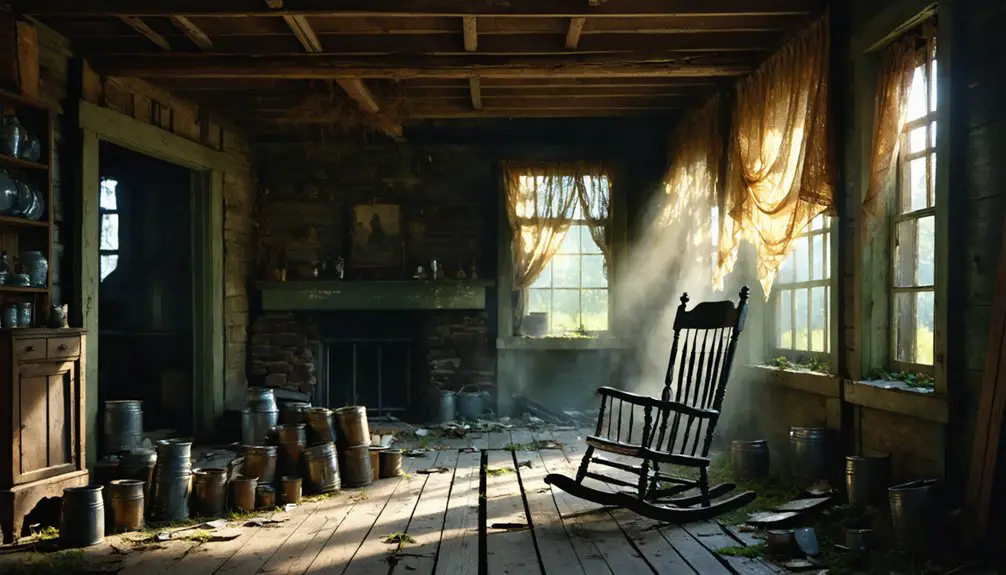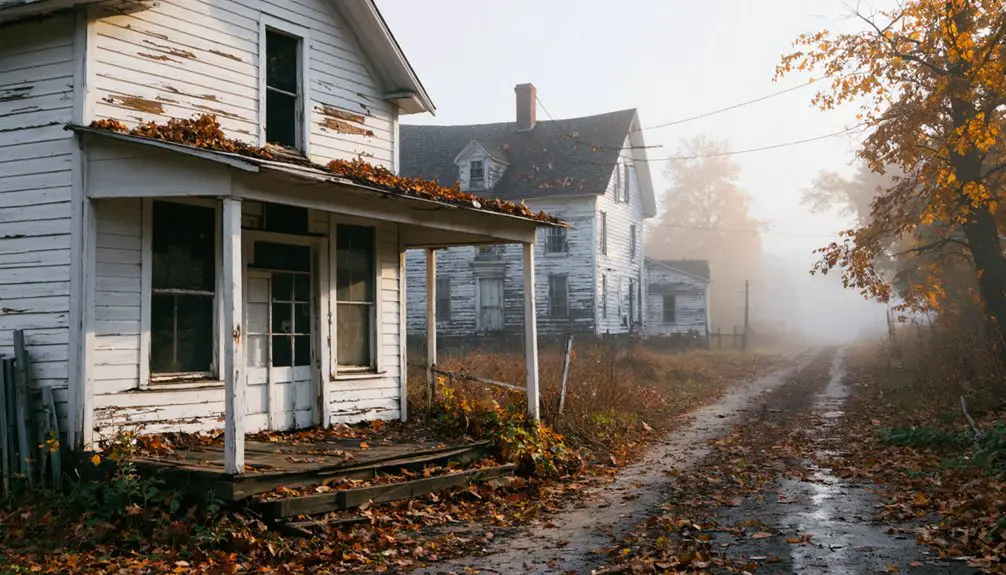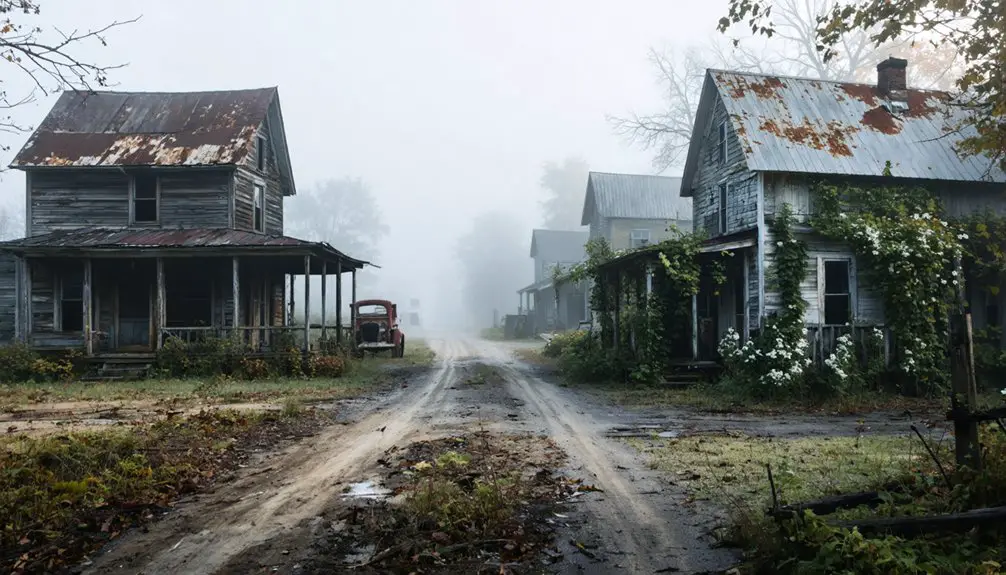You’ll discover numerous ghost towns along Central Vermont’s Winooski and Walloomsac Rivers, where 19th-century mill communities once thrived. These abandoned settlements, like Ricker Basin with its solitary standing house, tell stories of industrial prosperity and decline. Natural disasters, including the devastating flood of 1927, combined with harsh winters and economic shifts to empty these communities. Today, their foundations and ruins offer glimpses into Vermont’s rich manufacturing heritage, with more secrets waiting in their silent streets.
Key Takeaways
- Ricker Basin, located in Little River State Park, is a prominent ghost town featuring building foundations and one remaining standing house.
- Poor soil conditions and steep terrain led to the abandonment of many 19th-century settlements in central Vermont.
- The devastating 1927 flood contributed significantly to the decline and abandonment of several central Vermont communities.
- Historical mills along the Winooski River formed industrial communities that later declined due to economic shifts and larger manufacturers.
- Little River State Park offers interpretive trails and educational plaques detailing the socioeconomic history of abandoned settlements.
The Rise and Fall of Vermont’s Lost Communities
While many of Vermont’s ghost towns began as vibrant 19th-century settlements, their stories reflect the delicate balance between community resilience and environmental challenges.
You’ll find these lost communities were often established around natural resources, with residents building their lives near quarries, mills, and essential transportation routes. Today, visitors to places like Ricker Basin can find only foundations and one standing house from this bygone era.
Communities like Ricker Basin showcased the harsh realities of Vermont’s landscape, where poor soil quality and steep terrain tested settlers’ determination.
Despite initial prosperity, economic shifts proved challenging as transportation patterns changed and natural disasters struck. The devastating 1927 flood forced many to abandon their homes, while industrial accidents like the Greenbank’s Hollow mill fire destroyed critical infrastructure.
When railroads became obsolete and mills shut down, these once-thriving towns gradually faded into the forest, leaving only stone foundations and memories behind. The region’s sheep farming industry, which once supported fifteen thousand sheep in the Danville area during the 1870s, disappeared along with the communities that depended on it.
Industrial Heritage and Economic Decline
Your journey through these abandoned industrial sites reveals how the combined impact of new rail lines and canals initially boosted commerce but ultimately contributed to local decline as cheaper goods from larger manufacturing centers became more accessible.
The historic Champlain Canal opened in 1823, transforming Burlington into a major international inland port while enhancing maritime trade throughout the region.
You’ll find Vermont’s industrial heritage most evident in the dense concentration of 19th-century mills that once dotted the Winooski and Walloomsac Rivers, where nearly 36 mills operated along just two miles of waterway by 1890.
These mills produced a diverse range of goods, including woolen underwear and pottery, contributing significantly to the region’s economic prosperity.
The lives of slate quarry workers revolved around dangerous but steady employment, with entire communities forming around quarrying operations in places like Dorset and Pittsford.
Mill Operations and Decline
During the 19th century, Vermont’s industrial landscape thrived as mills emerged along rivers and railroad routes, transforming quiet rural areas into bustling manufacturing centers.
You’d find these mill operations strategically positioned near waterways, where dams and mill ponds powered the machinery that processed everything from wool to slate. The Jones and Lamson Factory exemplified this trend, becoming a manufacturing powerhouse along the Black River in Springfield.
As mill operations expanded, they’d shape entire communities around them. Workers, often immigrants from Ireland, Italy, and Slavic countries, lived in company housing and shopped at company stores.
But economic shifts would eventually spell doom for these industrial hubs. When larger industrial centers gained competitive advantages and local resources depleted, the mills couldn’t keep pace. Many of these locations in Rutland County remain forgotten today.
One by one, they shuttered their doors, leaving behind stone foundations and empty buildings as silent testimonies to Vermont’s industrial past.
Slate Quarry Worker Life
As Welsh immigrants arrived in Central Vermont during the 1850s, they brought specialized quarrying techniques that would transform the region’s slate industry. Processing operations took place in simple shanty mills scattered across the quarry landscape.
You’d find these workers living in shanties near the quarries, forming tight-knit communities where they shared both the burdens and triumphs of quarry life. By 1989, only twenty slate companies remained operational in the United States, marking a dramatic decline from the industry’s peak.
Daily work meant splitting massive slate blocks by hand, using hammers and chisels in harsh weather conditions. The worker community faced constant health risks from slate dust and physical strain, yet they persevered, establishing social institutions that reflected their Welsh heritage.
Transport Infrastructure Changes
When the West Castleton Railroad blazed its path in 1850, it transformed this quiet Vermont town into a bustling industrial hub, connecting the slate quarries to essential waterways like Lake Bomoseen and Glen Lake.
You could’ve witnessed the town’s strategic placement of mills alongside the water, maximizing transport efficiency during the industry’s golden age. The area became renowned for its slate mining operations, attracting numerous workers to the region.
But transport evolution brought dramatic changes. As automobiles gained prominence in the early 1900s, new freight patterns emerged, bypassing rail-dependent towns like West Castleton.
The shift from rail to road freight spelled trouble for your community’s industrial lifeline. Without reliable transport infrastructure, supply chains crumbled, businesses shuttered, and workers sought opportunities elsewhere.
What once served as the backbone of West Castleton’s prosperity became a stark reminder of changing times, leaving behind silent rail corridors and abandoned industrial ruins.
Natural Forces That Shaped Abandonment
The natural forces that devastated Vermont’s ghost towns struck with both sudden catastrophes and gradual erosion of community sustainability.
Natural calamities and slow decay worked in tandem to transform Vermont’s thriving communities into abandoned remnants of the past.
You’ll find that natural disasters like the 1927 flood ravaged communities such as Ricker Basin, while harsh winter conditions amplified the destruction of catastrophic events like Greenbank’s Hollow’s devastating mill fire.
Resource management decisions, particularly dam construction and water control measures, permanently altered the landscape you might’ve once recognized.
Vermont’s mountainous terrain and severe winters made it increasingly difficult for isolated communities to maintain their independence. Many residents reported seeing a black-clad rider passing through abandoned settlements on moonlit nights, a haunting reminder of the region’s rich folklore.
When these environmental challenges combined with industrial decline, you couldn’t sustain traditional ways of life.
The cold climate and unforgiving geography ultimately pushed many residents to seek opportunities in more accessible locations.
Haunting Tales and Local Legends

Deep within Central Vermont’s abandoned settlements, supernatural legends and ghostly tales have woven themselves into local folklore since the mid-1800s.
You’ll discover the infamous Bennington Triangle, where unexplained disappearances and Native American curses surround Glastenbury Mountain’s desolate terrain. The area’s eerie folklore includes accounts of the menacing “Bennington Monster” terrorizing travelers through the region.
At Ricker Basin, you’ll encounter spine-chilling ghostly encounters from campers who’ve braved overnight stays in this flood-ravaged ghost town.
Historic structures like Wilson Castle and Emily’s Bridge offer tangible connections to the supernatural, with visitors reporting physical evidence of spectral activity.
The haunted railroad bridge in Hartford still echoes with the tormented spirits of a tragic train fire, reminding you of the profound mysteries that persist in Vermont’s abandoned places.
Exploring Vermont’s Ghost Town Ruins Today
Among central Vermont’s most intriguing historical sites, abandoned settlements like Ricker Basin and Greenbank’s Hollow now offer fascinating windows into 19th-century life.
Step back in time through Vermont’s ghost towns, where abandoned foundations and weathered ruins reveal intimate glimpses of pioneer life.
You’ll discover these time capsules within state parks, where foundations, crumbling walls, and occasional standing structures await your exploration.
For the best urban exploration experience, head to Ricker Basin in Little River State Park, where you can wander through forest-reclaimed ruins during daylight hours.
While some visitors report ghostly encounters at dusk, you’re more likely to encounter interpretive plaques and historic remnants of mills, bridges, and farmhouses.
Remember to watch your step – these deteriorating structures require careful navigation.
You’ll find most sites accessible via hiking trails, though you’ll need to venture off-path to fully experience these forgotten communities’ remaining traces.
Historical Preservation and Cultural Impact

When you visit Vermont’s ghost town ruins today, you’ll find preservation efforts focused on stabilizing historic structures like the 1820 Harris House while protecting crucial remnants that tell the story of early settler life.
These preservation projects, led by local historical societies and volunteers, serve as living museums that showcase the region’s industrial heritage through restored blacksmith shops, mills, and cemeteries.
You can experience this preserved history firsthand through educational hiking trails at places like Little River State Park, where abandoned settlements reveal the socioeconomic forces that shaped these forgotten communities.
Preserving Historic Building Remnants
While many Vermont ghost towns have faded into obscurity, Central Vermont’s historic building remnants stand as crucial evidence to the region’s past.
Through careful building documentation and preservation techniques, you’ll find surviving structures that tell stories of vanished industries and forgotten settlements. Local preservation teams work tirelessly to protect these irreplaceable landmarks from New England’s harsh elements.
- Stone foundations and wooden frames reveal the craftsmanship of early settlers
- Weatherproofing and structural stabilization protect against further deterioration
- Original materials and construction methods provide authentic glimpses into past building practices
You can support these preservation efforts by joining local initiatives that safeguard these historic treasures.
Your involvement helps maintain these significant connections to Vermont’s industrial and agricultural heritage, ensuring future generations can learn from and experience these remarkable sites firsthand.
Community Memory and Stories
Beyond the physical remnants of Central Vermont’s ghost towns lie rich tapestries of oral histories and community narratives that span generations. You’ll find these stories deeply woven into the landscape of places like Greenbank’s Hollow, where community narratives paint vivid pictures of daily life, love, and loss stretching back over a century.
Memory preservation thrives through local historical societies and families with deep roots, who keep cultural connections alive through storytelling.
When you explore these abandoned towns, you’re walking through living memories that local descendants and neighboring communities continue to share. Their accounts help shape restoration projects, like those in West Dover, and maintain essential emotional bonds to these vanished places.
Through these shared memories, you’re connecting to a heritage that refuses to fade into obscurity.
Ghost Town Tourism Impact
Throughout Vermont’s ghost towns, tourism has emerged as a powerful force for both preservation and economic revival.
You’ll find the economic benefits extend beyond just ticket sales, generating around $1.7 million annually in visitor spending across local communities. While tourism challenges include securing consistent funding and maintaining aging structures, these historic sites offer invaluable cultural connections to Vermont’s past.
- Experience authentic boomtown artifacts and stories that showcase the region’s economic cycles
- Support local businesses through your visits, from restaurants to lodging
- Contribute to preservation efforts that keep Vermont’s heritage alive for future generations
The impact of ghost town tourism reaches deep into the community, balancing preservation costs against cultural value.
Your interest in these sites helps justify the significant investments needed to maintain these windows into Vermont’s rich history.
Frequently Asked Questions
Are There Any Fully Preserved Buildings Left in These Ghost Towns?
Like scattered pearls in time’s embrace, you’ll find Hyde Manor and its family cottages standing as rare fully preserved historic architecture, defying decay through dedicated preservation efforts and seasonal use.
What Survival Gear Is Recommended When Exploring Vermont Ghost Town Sites?
You’ll need survival essentials like a compass, map, first aid kit, water purifier, headlamp, fire starter, and paracord. Don’t forget extra layers and waterproof gear for Vermont’s unpredictable weather.
How Dangerous Are the Abandoned Quarries and Mine Shafts Today?
With pH levels as low as 2, abandoned quarries are deadly dangerous. You’ll face serious quarry hazards including toxic metals, unstable mine shafts that could collapse, and hidden gases that can kill instantly.
Which Ghost Towns Are Accessible During Winter Months?
You’ll find winter accessibility at Greenbank’s Hollow and Ricker Basin through hiking trails, while Somerset and Glastenbury require snowshoes or skis. Some sites near Burlington offer easier ghost town exploration during snowy months.
Are Metal Detectors Allowed at Vermont Ghost Town Locations?
You’ll need permission and permits for metal detecting at ghost towns due to strict regulations protecting historical artifacts. Many locations restrict or prohibit detecting, so always check local rules before exploring.
References
- https://www.youtube.com/watch?v=YrQNbrIrNT8
- https://obscurevermont.com/ghost-hollow/
- https://montpelierbridge.org/2022/10/ghost-towns-of-new-england/
- https://www.vermonter.com/scary-locations-vermont/
- https://vermontvacation.com/haunted-vt/
- https://en.wikipedia.org/wiki/List_of_ghost_towns_in_Vermont
- http://accdservices.vermont.gov/ORCDocs/_HistoricContext__IndustryandCommerceTheme_00000198.pdf
- https://www.uvm.edu/~hp206/2013/
- https://vermonthistory.org/journal/88/VH8801TheOtherMontpelier.pdf
- https://benningtonmuseum.org/portfolio-items/gilded-age-vermont/



